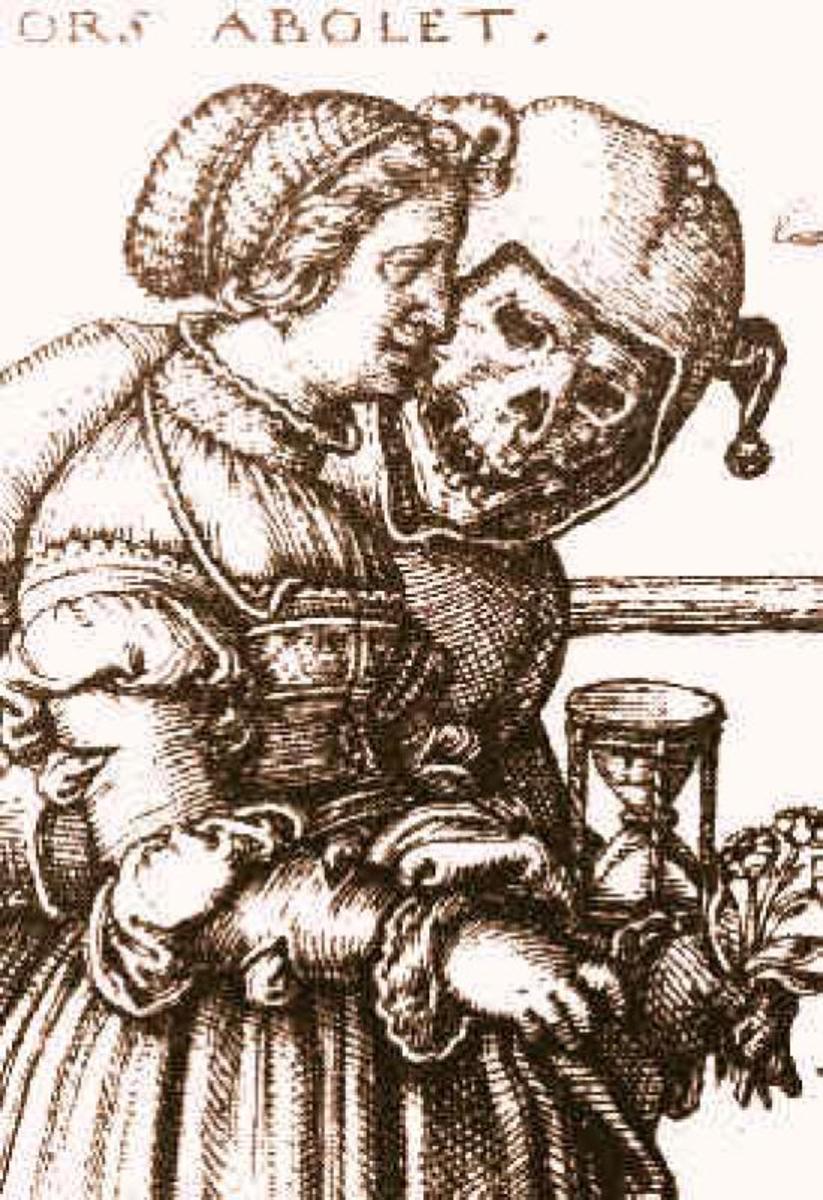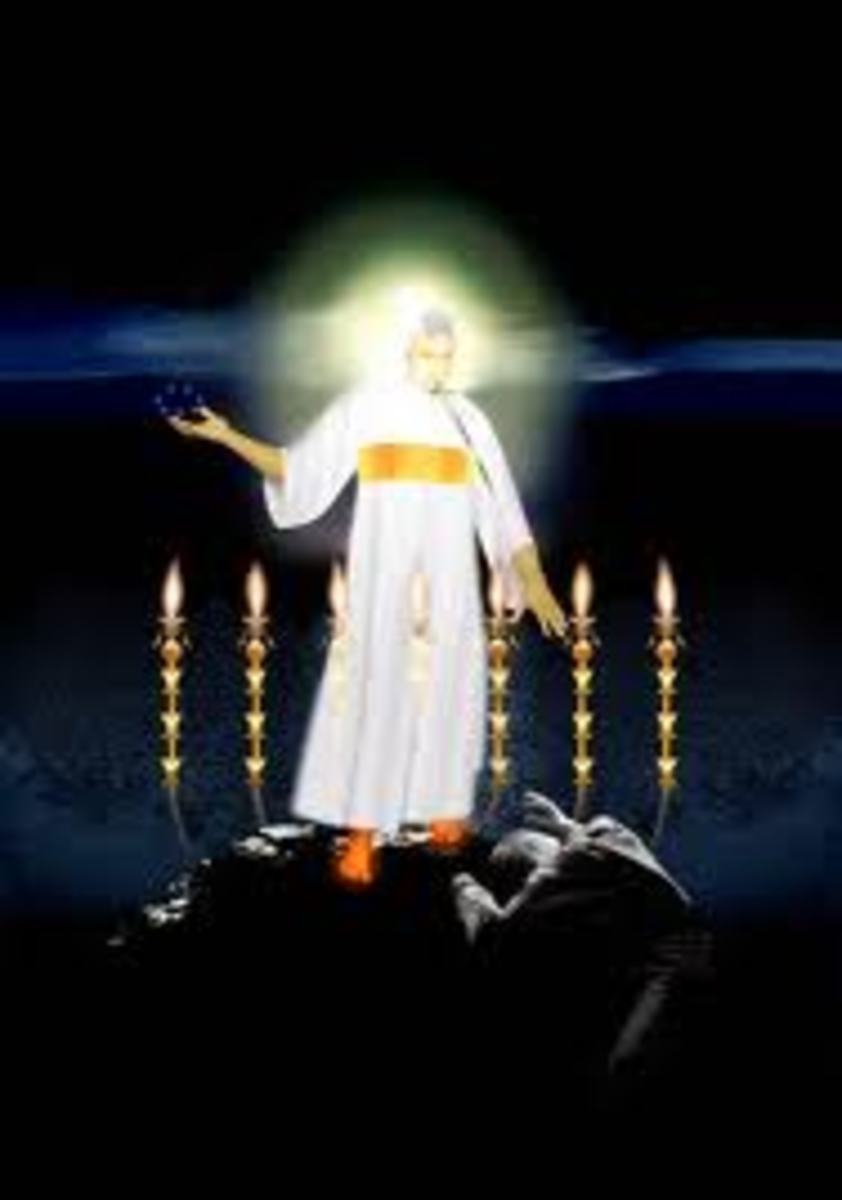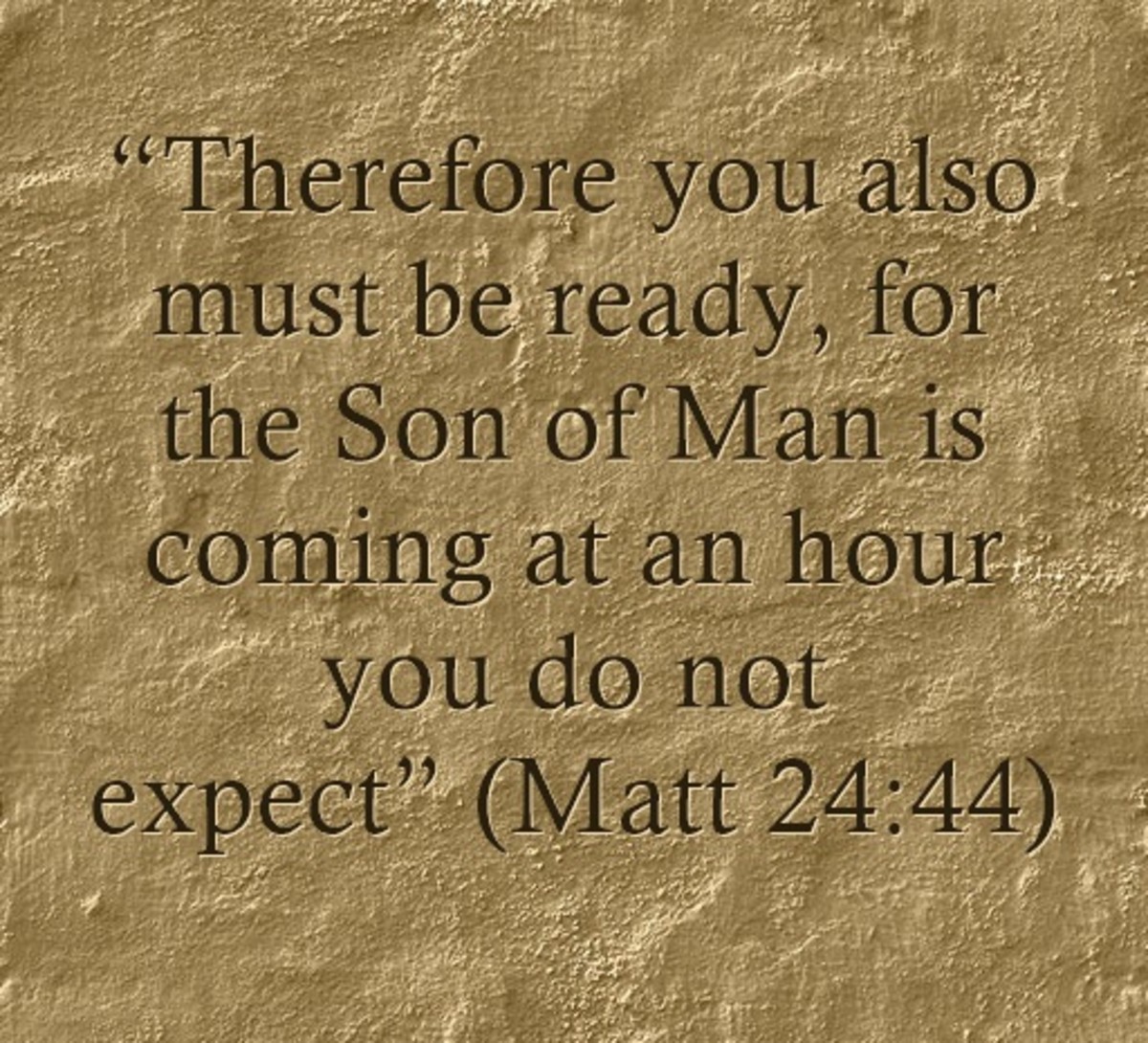Examining the Genesis Curse
The Key to Understanding Scripture
I am going to give you the key to understanding everything you read in Scripture; indeed, in life.
When you read scripture, especially the Old Testament, you will see a constant cycle of condemnation and forgiveness.
Take, for example, the book of Isaiah. You read through Isaiah, and you will see one chapter prophesying the destruction and misery of Israel because of their rebellion; and in the very next chapter, you will see God pleading with the people to come back to him and be forgiven, and promising future blessing and reconciliation.
For those people who lived within the period of the Old Testament this was a profound mystery. How could a Loving God condemn, and how could a Holy God forgive?
In fact, we know that this was a mystery to the people prior to Christ because the Bible tells us so:
1 Peter 1:10-12
English Standard Version (ESV)
10 Concerning this salvation, the prophets who prophesied about the grace that was to be yours searched and inquired carefully, 11 inquiring what person or time the Spirit of Christ in them was indicating when he predicted the sufferings of Christ and the subsequent glories. 12 It was revealed to them that they were serving not themselves but you, in the things that have now been announced to you through those who preached the good news to you by the Holy Spirit sent from heaven, things into which angels long to look.
John 5:39
English Standard Version (ESV)
39 You search the Scriptures because you think that in them you have eternal life; and it is they that bear witness about me,
Think of it like an algebraic equation. In order to solve the equations, both sides need to be balanced and reconciled. The puzzle lies in finding how do we balance the one against the other?
This puzzle begins in the beginning pages of the Bible, in what Christians call “The Fall”. And herein lies a hint to the solution.
The Fall
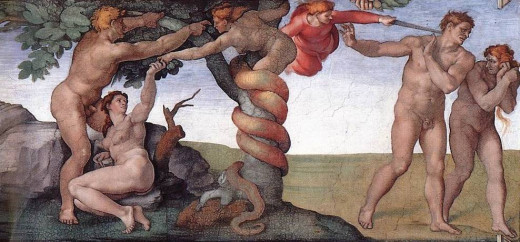
Introduction
Christian or not, most people are familiar with the broad details of what theologians term “The Fall” as told by the biblical book of Genesis:
God tells the first two humans not to eat an apple, a snake tempts the woman to disobey; she eats the apple and seduces the man into eating it too, with the result that God kicks them all out of paradise.
A dispassionate observer might find the story to be contrived and mythic in the extreme, what with its talking snakes and forbidden fruit.
Nevertheless, the story has become iconic in itself. The term “forbidden fruit,” the snake becoming a symbol of seduction, and the apple becoming a symbol of temptation are all results of the integration of this tail into the collective mindset of Western Culture.
However, the simplified summary of the story as outlined above overlooks a number of important details in this story. Moreover, aware as they are of the story, most laymen are not entirely acquainted with the crucial capstone of this text: The Curse.
The Creation and Station of Man and Woman
Without recounting every single detail of the story leading up to the curse, the features of that story relevant to our discussion are these:
God Formed Man out of the Dust of the Earth
“…then the Lord God formed the man of dust from the ground and breathed into his nostrils the breath of life, and the man became a living creature.” (Genesis 2:7 ESV)
God instructed Man to work the ground
“The Lord God took the man and put him in the garden of Eden to work it and keep it.” (Genesis 2:15)
God gave Man complete freedom to enjoy the fruit of his labor with one exception
“And the Lord God commanded the man, saying, “You may surely eat of every tree of the garden…”” (Genesis 2:16 ESV)
God promised that death would be the result of disobedience
“…but of the tree of the knowledge of good and evil you shall not eat, for in the day that you eatof it you shall surely die.” (Genesis 2:17 ESV)
Man was created superior to all animals
“The man gave names to all livestock and to the birds of the heavens and to every beast of the field. But for Adamthere was not found a helper fit for him.” (Genesis 2:20 ESV)
Woman was created equal to Man, and they were in perfect unity
“Then the man said,
“This at last is bone of my bones
and flesh of my flesh;
she shall be called Woman,
because she was taken out of Man.”” (Genesis 2:23 ESV)
The important things to note in the second chapter of Genesis are the relationships. A simple diagnosis of the relationships might look something like this:
God > Man = Woman > Animals
Another important feature is the relationship between Man and the earth, where “Man” refers specifically to the male, and “Earth” refers to the ground. There is a symbiotic relationship here wherein the earth nurtures Man with its produce and Man in turn tends, protects, and cares for the earth.
Temptation and Fall
This is the portion of the story most familiar to people in general:
“Now the serpent was more crafty than any other beast of the field that the Lord God had made.
“He said to the woman, “Did God actually say, ‘Youshall not eat of any tree in the garden’?” And the woman said to the serpent, “We may eat of the fruit of the trees in the garden, but God said, ‘You shall not eat of the fruit of the tree that is in the midst of the garden, neither shall you touch it, lest you die.’”
“But the serpent said to the woman, “You will not surely die. For God knows that when you eat of it your eyes will be opened, and you will be like God, knowing good and evil.”
“So when the woman saw that the tree was good for food, and that it was a delight to the eyes, and that the tree was to be desired to make one wise,she took of its fruit and ate, and she also gave some to her husband who was with her, and he ate.” (Genesis 3:1-6 ESV)
What is noteworthy about this passage is the order in which the temptation occurred. Curiously, a talking snake is introduced into the picture. One of only two talking animals in the Bible, the snake gets a very cursory introduction, simply mentioned as the craftiest of all animals.
Evangelical Christians will cite three references (2 Corinthians 11:3; Revelation 12:9; 20:2) in the New Testament that appear to indicate that the snake was, in fact, Satan. The character of Satan has a long and colorful history in both Old and New Testaments. The name “Satan” means “The Accuser,” and in practically every one of his explicit appearances, he takes upon himself the task of disrupting the relationship between God and humans.
It is understandable, then, why Christians would tend to want to identify the serpent as Satan.
Those who do not take the scriptures to be a unified, inspired text would tend to look at the talking snake as simply a byproduct of mythology. Whether or not one takes this story to be a mythic tale, it is significant that talking animals are not a common feature of the Hebrew Scriptures. This being so, it is worthwhile to ask the question “why a talking snake?” If this animal was Satan incarnate, why choose the form of a limbless reptile?
One possible answer is the relationship the snake has to the ground. Of the “beasts of the field” (Genesis 3:14) snakes are closest to the ground. This becomes an accentuating feature of the irony and obscenity of this passage; that being that the Woman chose the word of a beast over the word of God. With no real explanation as to why, the Man then submits to the rebellious decision of the Woman.
Note the chain of rebellion and how it becomes the reverse order of the order of authority detailed above:
Animal --> Woman --> Man --> God
Since God gave the command not to eat the fruit to the Man prior to the creation of the Woman, presumably, it was the Man who told the Woman about the restriction. The Woman thusly takes the word of the animal over the word of the Man, who takes the word of the Woman over that of God.
What follows this violation is a moment of self-awareness that comes with the “Knowledge of Good and Evil.” About this much can be said, however the real feature of this article is what follows: The Curse.
Responsibility, Blame, Curse
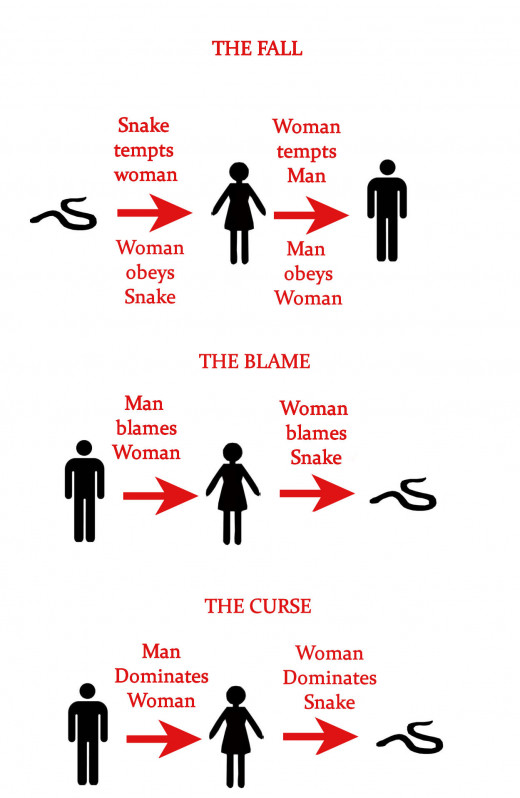
The Curse
When God finds the Man and Woman attempting to hide from him in shame, and covered in their comically bad outfits made of leaves, he quickly extracts from them their excuses for violating his one command:
“He said, “Who told you that you were naked? Have you eaten of the tree of which I commanded you not to eat?” The man said, “The woman whom you gave to be with me, she gave me fruit of the tree, and I ate.” Then the Lord God said to the woman, “What is this that you have done?” The woman said, “The serpent deceived me, and I ate.”” (Genesis 3:11-13 ESV)
Note the chain of blame here. God first turns to the Man for accountability. God had given this command directly to the Man, and so the Man was the one he holds responsible for the violation.
Man’s response is to blame the Woman for giving him the fruit. However, implicit in the blame is God himself. The man responds “The woman whom you gave to be with me…”
The Man turns the responsibility back around to God for creating the Woman for him in the first place. This is interesting in that the Man implies that he saw the Woman as a proxy for God, and that it was by God’s own authority that he received the fruit from her. The Man tries to hold God directly responsible for the actions of the Woman.
God turns to the woman who blames the snake. Note that God does not ask for an explanation from the snake as to why he would tempt the Woman. This fact may be telling when it comes to determining the nature and motivations of the serpent. Thus the chain of blame goes:
Man --> Woman --> Snake
While this chain is technically correct, none of the characters involved takes responsibility for their actions, each abdicating to the authority of the one who caused their trespass.
Thus, God lays out a curse on each party starting from the bottom of the chain of blame. The serpent’s curse is as follows:
“The Lord God said to the serpent,
“Because you have done this,
cursed are you above all livestock
and above all beasts of the field;
on your belly you shall go,
and dust you shall eat
all the days of your life.
I will put enmity between you and the woman,
and between your offspring and her offspring;
he shall bruise your head,
and you shall bruise his heel.”
To the woman he said,
“I will surely multiply your pain in childbearing;
in pain you shall bring forth children.
Your desire shall be foryour husband,
and he shall rule over you.”
And to Adam he said,
“Because you have listened to the voice of your wife
and have eaten of the tree
of which I commanded you,
‘You shall not eat of it,’
cursed is the ground because of you;
in pain you shall eat of it all the days of your life;
thorns and thistles it shall bring forth for you;
and you shall eat the plants of the field.
By the sweat of your face
you shall eat bread,
till you return to the ground,
for out of it you were taken;
for you are dust,
and to dust you shall return.””
A more succinct summary of the curses would be as follows:
Serpent:
- Humiliation above all “beasts of the field”
- Eats dust
- Conflict with Woman which she will win via her offspring (although not without injury)
Woman
- Pain in childbirth
- Conflict with Man which she will lose
Man
- Struggle and pain while trying to make a living
- Conflict with earth (soil) which Man will lose
- Death
Cycle of Conflict

The Cycle of Conflict
Conflict is the first great theme of the Curse. Prior to The Fall there is no conflict of any kind. Man lived in harmony with the land, coexisting with animals and tending the ground in ease and contentment Woman and Man lived in blissful equality. The Curse now brings about a raging conflict.
There is now conflict between beast and human. The serpent is at odds with the Woman, a conflict the Woman ultimately wins. The Woman, in turn, is at odds with the Man, a conflict the Man ultimately wins. The Man is now at conflict with the ground he once tended with ease, and the Ground wins this conflict. Finally the serpent eats the dust of the ground, gaining victory over the Man; and the cycle repeats itself.
Curse Cycle
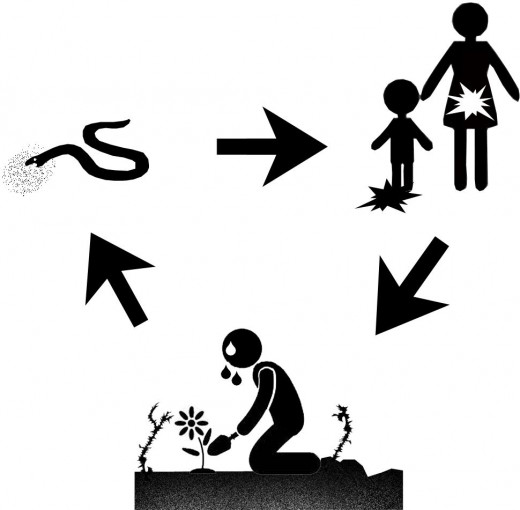
The Cycle of Life and Death
The case has been made that God’s warning to Adam “…in the day that you eat of it you shall surely die.” (Genesis 2:17 ESV) was, at worst, an outright lie or, at best, an exaggeration of the consequence. Neither the Woman nor the Man dropped dead on the spot upon ingesting the fruit.
However, of the two overall themes of this curse cycle, the most prominent is entirely about Death.
The Serpent is cursed in three ways: it is humiliated, made to eat dust, and crushed under heal of the Woman’s offspring.
The serpent’s humiliation makes this reptile more akin to a worm. Snakes are not known for ingesting dirt, but worms are.
Thusly one of the most seemingly erroneous and least important details of the serpent’s curse becomes one of its most prominent features. In making the serpent akin to the worm, God makes the serpent an avatar of death itself.
If we accept the premise that serpent=death, the conflict between the serpent and the woman becomes clear: the Woman defeats Death through her offspring. Having the unique ability to bring new life into the world, the Woman keeps Death at bay, even if Death “bruises the heal” of the offspring.
This gift of the Woman to bring forth new life does not come without cost, however. Her gift becomes her curse in that she experiences enormous pain in childbirth.
The Man, who was formerly in harmonious symbiosis with the earth, now experiences an epic conflict. Still dependent on the earth for his living, the earth is now harsh and resistant to his attempts to cultivate it. Man is destined to lose this battle with the earth, being consumed in death by the very soil he attempts to tame.
This brings the cycle back around to the serpent, who consumes the dust of the ground.
This becomes an endless loop:
Woman > Death > Man.

The "Protoevangelium"
For those who do not see the Bible as a comprehensive and unified text inspired in some sense by God, this is as far as we can go. The Curse Cycle is an incredibly complex, nuanced, and subtle summation of the Human Condition, caught in an endless loop of life, death, and conflict with both nature and one another.
The Hebrew writers of this text, while not inspired by God, were master poets and philosophers who managed to encapsulate the struggle faced but humanity from the dawn of time.
However, for Christians who teach Biblical unity and inspiration, there is one additional feature of the Curse worthy of examination.
In the curse cycle, God’s final curse on the serpent reads as follows:
“I will put enmity between you and the woman,
and between your offspringand her offspring;
he shall bruise your head,
and you shall bruise his heel.” (Genesis 3:15 ESV)
The reference to the offspring bruising the serpent’s head is taken to indicate Jesus crushing Satan, and the reference to the serpent bruising the heel is taken to indicate the sacrifice Jesus needed to make on the cross. However the really interesting feature of this passage is the word “offspring.” In the original Hebrew, this word is literally “seed.” When this word is used figuratively for offspring, it is always used in reference to the male contribution to reproduction, not the female. This Hebrew word for offspring only references a woman once in scripture, and it is this passage. That a woman would have “seed” without intercourse could very well indicate a virgin birth.
Theologians refer to this passage as the “Protoevangelium” or “First Gospel,” and take it to be God’s first promise to humanity that the curse of death and conflict would ultimately be ended by the “seed” of the woman.
This lends an additional level of profundity to the Curse cycle, because it indicates that this chain would be broken and that eventually humanity would be freed. If this is true, than the judgment of the Curse contains an element of mercy as well.
That the Curse includes an element of mercy is already undeniable. Rather than simply annihilating the first Man and Woman for their disobedience, God perpetuates the race while simultaneously fulfilling his promise of immanent death. It is worth noting that it is only after the Fall that the Woman’s fertility is brought into focus. After the Fall, Adam names his wife Eve, which sounds like the Hebrew word for “Life-Giver,” because “she was the mother of all living”(Genesis 3:20). Immediately after being expelled, they begin to conceive children.
While God initiates struggle in life for both the Man and the Woman, their struggle yields results: Woman brings forth offspring and Man brings forth fruit.
This struggle mirrors the struggle God has in his relationship with the human race. On the one hand, his justice demands that he punish wrongdoing. On the other hand, his love and grace demand that he not abandon humanity, but redeem them.
It is worth noting that one of Jesus’ favorite analogies in his description of the Kingdom of God was agricultural. The redeemed and the damned were compared to wheat and weeds, one of which would be brought to harvest, the other burned.
He compares the spreading of the Gospel to the sewing of seeds, some of which will take root and grow, others of which will wither and die.
Likewise the coming of God’s kingdom is compared in both Old and New Testaments to childbirth, including the birth pangs that precede the actual birth.
The message is clear: humanity’s rebellion leads to a state in which no triumph comes without toil, no victory without struggle, and no life without death.


